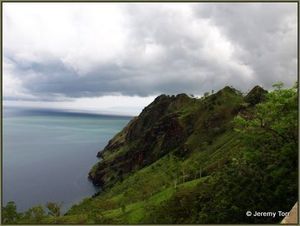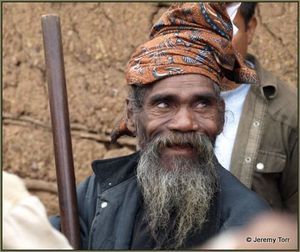Travelling to Timor Leste is like travelling back in time to a less frantic age. But getting there is a cinch now that regular air services have started from Changi, Singapore. By Jeremy Torr.

Living quarters in Timor. No luxuries, but a uniquely unspoilt place to visit
Singapore 5 March 2011. Most flying to Timor Leste is easy. Just jump on a plane at Singapore’s Changi airport. It’s a four hour flight to Nicolau Lobato airport in Dili - but when you arrive it’s like you have been traveling in time.
“Bon dia’” said the immigration official, smiling broadly as he took my passport to enter the visa details - by hand, into a great big book. No computers here; no electronic tickets or passport scanners. Timor Leste is still a very under-developed country, and this is where much of its charm lies. Admittedly Dili, the capital, has its share of street chaos with hooting mopeds, food vendors, the occasional internet café, and chunky 4WDs.

Local people are fiercely proud of their heritage, yet still friendly and hospitable
But venture just a few kilometers up or down the coast to Manatuto or Liquica, or head inland up into the mountains towards Maubisse and the change is dramatic. As Jose Ramos Horta, president of Timor Leste, said to us, “the Portuguese were here for 400 years, and they did basically nothing while they were here.” All they left when they went was their language, and a deep abiding Roman Catholic faith.
Unspoilt Nature
No scenery-spoiling motorways, no river dams, no railways, almost nothing apart from a few colonial buildings, an odd church or two and the remains of an old fort. All of which left the countryside as untouched by modern progress as anywhere in the world. “We are a poor country, but we are proud of it and want to welcome people here,” added the president.

The cliffs at Ponta Hatolana Rein are absolutely stunning
“This,” said our guide the next day, “is some of the most stunning scenery.” He was right. We had driven about forty minutes out of Dili, east along the coast road past the huge statue of Christ the Redeemer on its crag at Ponta Fatossidi (Cape Fatucama), through tiny thatched-hut villages with running kids and groups of fishermen sitting playing cards. Once through the villages, the cliffs at Ponta Hatolana Rein are simply stunning. The road clings to the edge some 250metres above tiny white sand beaches as the cliffs, covered in green tropical plants and huge white gum trees, plunge into the pure blue sea. The rock faces glowed red, black, and white with marble in the afternoon sun, fit for a scene from the next James Bond movie – but without a soul in sight. We passed by Dollar Beach (it’s called that because the locals used to charge a dollar to drive onto it) and stopped in the tiny hamlet of Berhedan for local honey, sold in old rum bottles yet tasting of native flowers. Every place we passed people waved and smiled – but they did caution us to be careful where we swam. The national animal is not the crocodile for nothing.

Buying local honey is a very interactive process; the whole village is likely to join in!
Next day we took a trip into the hills, to a tiny village near Letefoho where a new school was being opened. The road there can be described as a challenge, you definitely need a 4WD. Winding up across the mountains we had wonderful views out over Dili to the sea, and glimpses of the scores of tiny hamlets that seem to hide behind every curve of the road and hilltop. Apparently the local people shunned the more open land nearer the sea and preferred to live in the hills where it was harder for marauding tribes to mount surprise attacks.
Live to Eat
Whatever the reason, this fondness for hill-dwelling has preserved a unique way of life. Tiny fenced plots of cassava and corn sit next to rushing streams and thatched storage barns. Dogs and chickens wander about on single-file paths between rice patches. Men and women in locally woven turbans herd the local cow between smoky huts. All this makes trekking and walking in this area excellent, but check your accommodation options first – hotels are thin on the ground.

Ceremonies and dances are very much part of Timorese life
Once the ceremony to open the school started, the local orchestra – a group of older women with gongs – led the festivities. They were joined by village elders in ornate feather and silver headdresses – and some very cool shades. Everybody joined in, laughing, dancing, stamping to the music, eating pigs livers, drinking strong local coffee and eating super-sweet milky puddings. The celebrations went on for hours – but there was so much of interest it was never tiring. A Singaporean policeman, on local duty with the UN, stated the obvious: “it is very different from Singapore.” About as different as you can get.
Before we left Timor Leste, I thanked our guide and asked him what he wanted me to tell our readers. “Please tell your readers Timor Leste is a safe and friendly place to visit,” he said. He didn’t need to say that; it is both those and more. It is a stunningly beautiful destination, with a new experience around almost every corner. And thanks to all those old Portuguese roads, there are plenty of those.
Photos by Jeremy Torr
- Getting there: Air Timor flies three times a week direct from Changi.
- Staying there: From US$35-130 per night.
- http://www.timorleste-hotels.com/, http://www.turismotimorleste.com/en/
- Money: US dollars
- Best time to visit: May – August (spring/summer)
- Visa: USD30 on arrival

